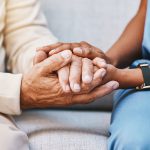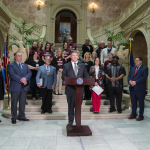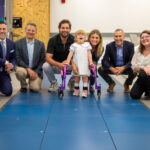 It was 2007 and Katie Smith was a senior in nursing school. She played rugby at Penn State, soccer before that, and was working two waitressing jobs. It was late at night when she nodded off in her car. Her head bobbed, but only for a second.
It was 2007 and Katie Smith was a senior in nursing school. She played rugby at Penn State, soccer before that, and was working two waitressing jobs. It was late at night when she nodded off in her car. Her head bobbed, but only for a second.
Smith’s car crossed the center line. Her eyes flashed open. She was in the other lane. She veered, but overcompensated.
She was rushed to a local hospital in Buffalo, New York, where doctors worked to keep her alive. They stabilized her neck with a plate and screws. She suffered a cervical vertebra C6-C7 spinal cord injury, which doctors believed resulted from whiplash.
On Sunday, she will sit in her handcycle, adrenaline pumping as she maneuvers across Pittsburgh’s bridges and up the hill into Oakland — 26.2 miles of grueling excitement at the Dick’s Sporting Goods Pittsburgh Marathon. She will finish her third marathon with pride.
“The best part of the marathon is having the ability to ride in the street,” Smith said, her voice filling with passion as she relives her past two marathons. “The hills and the bridges are so cool and the support Pittsburgh provides is awesome.”
The road to recovery
None of this would’ve been possible without her brother’s commitment to finding a facility that would provide Smith the care she needed. While she was being stabilized, he quickly started researching top rehabilitation facilities.
He chose the UPMC Rehabilitation Institute for its reputation, which at the time, was in the South Side. His family set up a tour of the facility, met with therapists, and determined it was the best fit for Smith. She was admitted to UPMC that August, one month after her accident.
“When I came to UPMC, I was using a power wheelchair and I was not able to feed myself,” Smith said. “I wasn’t able to dress myself. I lost all my independence. I couldn’t navigate the world.”
She started therapy six days a week – occupational and physical therapy every morning and afternoon, and speech therapy to ween her off her tracheotomy.
Smith learned how to adapt to activities and operate in a wheelchair. How could she dress herself from a laying down position? How could she eat and go to the bathroom? She learned the ins and outs of necessities that are often taken for granted.
Her doctor, Dr. Gilbert Brenes, would often meet her in the lobby for ice cream dates, where he would answer her many questions.
“He was fabulous,” she said. “They just don’t make doctors like that.”
Dr. Richard Barbara, a psychologist on the rehabilitation unit, and a paraplegic himself, helped Smith change her mindset on learning how to adapt in a wheelchair.
Staying active
 Smith remained active, even in the hospital.
Smith remained active, even in the hospital.
“I became friendly with the nurses and would clip their heels, or push the medical cart down the hallway so they couldn’t find it,” she said. “Once, I slammed into a desk hard with my wheelchair and someone mentioned I should take up wheelchair rugby. I went to a practice and fell in love.”
Smith found a support system playing sports, and this strong circle of mentors inspired her to pay it forward where it all began at UPMC Mercy. She visited the Spinal Cord Injury Peer Support Group to mentor patients. That is where she met Ashli Molinero, director of the Disabilities Resource Center. Smith casually mentioned she had an interest in the Pittsburgh Marathon, but had only been on a hand cycle a few times before.
Smith recalled that Molinero’s only response was, “Why don’t you just do it?”
She went on to complete her first race as a tribute to Brenes, who was instrumental in getting hand cycles in the marathon.
Finding purpose
Outside of sports, Smith was determined to pursue a career she was passionate about. She decided not to go back to nursing school because she felt she couldn’t pursue it the way she once wanted. Instead, she found her calling in the classroom. During her recovery, first graders from her native school district sent her pictures and letters every day. When she got out of the hospital, she volunteered in their classroom to give back, and she fell in love. She went back to school at Seton Hill for psychology and elementary and special education.
Today, she works as a youth leadership coordinator, where she helps youth with disabilities transition to adulthood and educates parents on how they can best support their children.
“I never thought I’d make it up the hill into Oakland, but I got there and put it granny mode,” Smith said referring to the first time she completed the marathon. “I had people cheering me on. I was the ‘little engine that could.'”
To those around her, the metaphor extends beyond her first marathon – it applies to her heart, her recovery, her life.








